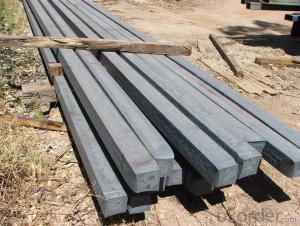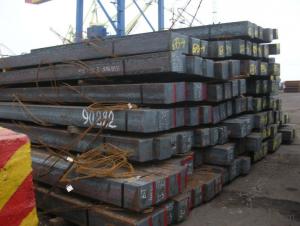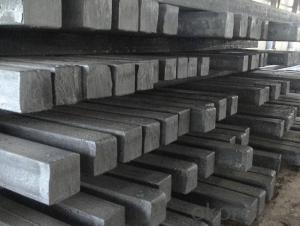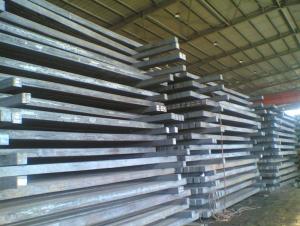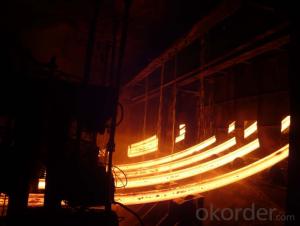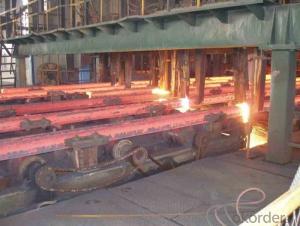Hot Rolled Square Steel Billet 3SP Standard 185mm
- Loading Port:
- Shanghai
- Payment Terms:
- TT OR LC
- Min Order Qty:
- 2000 m.t.
- Supply Capability:
- 10000 m.t./month
OKorder Service Pledge
OKorder Financial Service
You Might Also Like
Structure of Hot Rolled Square Steel Billet 3SP Standard 185mm

Description of Hot Rolled Square Steel Billet 3SP Standard 185mm
PPGI is made by cold rolled steel sheet and galvanized steel sheets as baseplate, through the surface pretreatment (degreasing, cleaning, chemical conversion processing), coated by the method of continuous coatings (roller coating method),
and after roasting and cooling. Zinc coating: Z60, Z80, Z100, Z120, Z180, Z275, G30, G60, G90
Alu-zinc coating: AZ60, AZ80, AZ100, AZ120, AZ180, G30, G60, G90
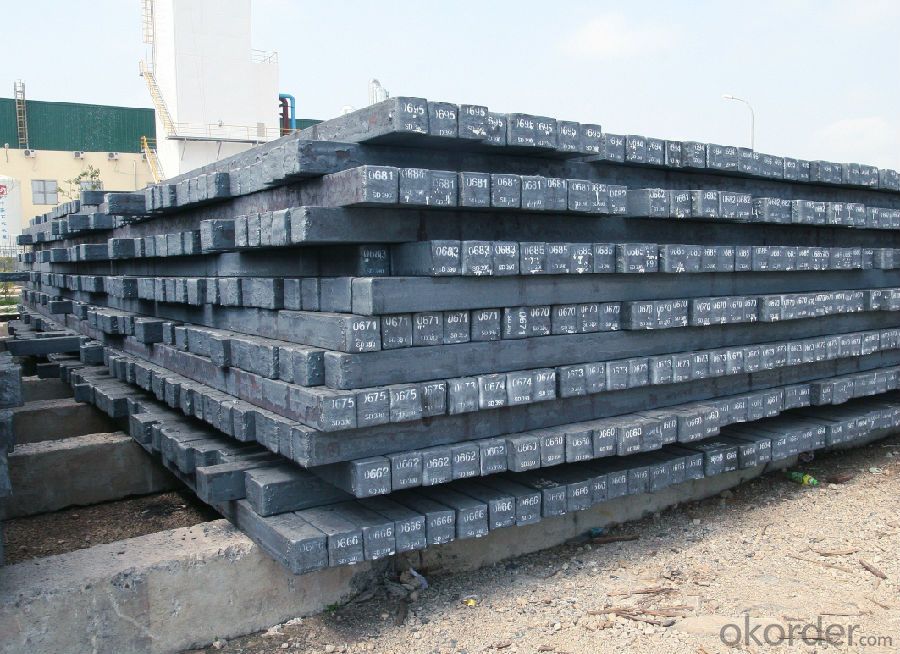
Main Feature of Hot Rolled Square Steel Billet 3SP Standard 185mm
1) Excellent corrosion resistance: The zinc layer provides a good protection of Pre-painted Galvanizeed Steel Sheet.
2) High heat resistance: The reflective surface of the material aids in efficiently reflecting the sunlight away and in turn reducing the amount of heat transmitted. The thermal reflectivity converts into energy savings.
3) Aesthetics: Pre-Painted Galvanized steel sheet is available in plethora of patterns and multiple sizes as per the requirements that given by our customers.
4) Versatility: can be used in the various areas.Standard seaworthy export packing: 3 layers of packing, inside is kraft paper, water plastic film is in the middle and outside GI steel sheet to be covered by steel strips with lock, with inner coil sleeve.
Applications of Hot Rolled Square Steel Billet 3SP Standard 185mm
1) Automotive bodies: filters, fuel tanks, etc.
2) Construction materials: roofings, welding pipes,
3) Electric and electronic appliances: computer cans, etc.
4) Steel cans: containers, etc.
5) Steel furniture: washing machines, refrigerators, microwaves, etc.
6) Drums
7) Office equipment: printer, recorders, etc.
8) Motors and transformers
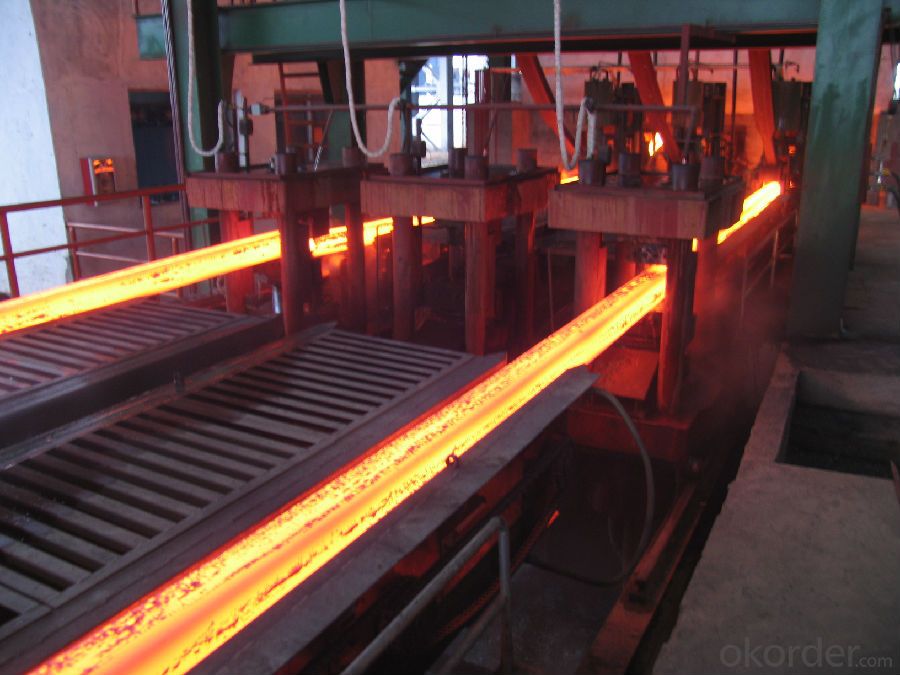
Specifications of Hot Rolled Square Steel Billet 3SP Standard 185mm
| Classified symbol | Yield Point Minimum N/mm2 | Tensile Strength Minimum | Elongation Minimum % | Application | ||||
| N/mm2 | Nominal Thickness mm (t) | |||||||
| JIS | Yogic | 0.25-0.4 | 0.4-0.6 | 0.6-1.0 | 1.0-1.6 | |||
| G3312 | specification | |||||||
| CGCC | CGCC | -205 | -270 | -20 | -21 | -24 | -24 | Commercial |
| CGCD | CGCD | --- | 270 | --- | 27 | 31 | 32 | Drawing |
| --- | CG340 | 245 | 340 | 20 | 20 | 20 | 20 | Structural |
| CGC400 | CG400 | 295 | 400 | 16 | 17 | 18 | 18 | Structural |
| CGC440 | CG440 | 335 | 440 | 14 | 15 | 16 | 18 | Structural |
| CGC490 | CG490 | 365 | 490 | 12 | 13 | 14 | 16 | Structural |
| CGC570 | CG570 | 560 | 570 | --- | --- | --- | --- | Structural |
| ASTM Designation | Yield Point Minimum | Tensile Strength Minimum | Elongation Minimum % | Application | Q/BQB 445-2004(China standard) | ASM A653/A653M | JISG 3312 | |
| ksi(MPa) | ksi(MPa) | TDC51D+Z | (CS TYPE A+Z) | CGCC | ||||
| A653(M)-99 CS TYPE A,B,C | --- | --- | --- | Commercial | TDC52D+Z | CGCD | ||
| A653(M)-99 FS | --- | --- | --- | Lock Forming | TS250GD+Z | (G250+Z) | - | |
| A653(M)-99 DS | --- | --- | --- | Drawing | TS300GS+Z | (G300+Z) | CGC 400 | |
| A653(M)-99 SS Grade33(230) | 33(230) | 45(310) | 20 | Structural | TS350GD+Z | (G350+Z) | CGC490 | |
| A653(M)-99 SS Grade37(255) | 37(255) | 52(360) | 18 | Structural | TS550GD+Z | (G550+Z) | CGC570 | |
| A653(M)-99 SS Grade40(275) | 40(275) | 55(380) | 16 | Structural | ||||
| A653(M)-99 SS Grade50(345) | 50(345) | 65(450) | 12 | Structural | ||||
| A653(M)-99 SS Grade80(550) | 80(550) | 82(570) | --- | Structural | ||||
FAQ of Hot Rolled Square Steel Billet 3SP Standard 185mm
We have organized several common questions for our clients,may help you sincerely:
1. How Can I Visit There?
Our company is located in Tianjin City, China, near Beijing. You can fly to Tianjin Airport Directly. All our clients, from home or aboard, are warmly welcome to visit us!
2. How Can I Get Some Sample?
We are honored to offer you sample.
3. Why choose CNBM?
1, ISO, BV, CE, SGS approved.
2, Competitive price and quality.
3, Efficient service team online for 24 hours.
4, Smooth production ability(50000tons/month) .
5, quick delivery and standard exporting package.
6, Flexible payment with T/T, L/C, Paypal, Kunlun bank, etc.
- Q:What are the different surface treatments for improved surface hardness in steel billets?
- To enhance the surface hardness of steel billets, there are various surface treatments available. These treatments aim to increase the wear resistance and durability of the steel, making it suitable for a range of industrial uses. One frequently used method is carburizing, which involves exposing the steel billet to a carbon-rich environment, like methane or propane. This process introduces carbon into the surface, creating a hard layer called a case that significantly boosts the billet's surface hardness. Another technique is nitriding, where the steel billet is exposed to a nitrogen-rich atmosphere at elevated temperatures. This causes nitrogen atoms to diffuse into the surface, forming a hard nitride layer. Nitriding not only enhances surface hardness but also improves resistance to wear and corrosion. Induction hardening is a third method that utilizes electromagnetic induction to rapidly heat the steel billet's surface. After reaching the desired temperature, the billet is quickly cooled, resulting in a hardened surface layer. This treatment is especially effective for localized hardening of specific areas. Furthermore, shot peening is a surface treatment that involves bombarding the steel billet's surface with small, high-velocity steel shots. This process induces compressive stresses in the surface layer, thereby increasing hardness and fatigue resistance. Each of these surface treatments comes with its own advantages and disadvantages. The choice of treatment method depends on the specific requirements and intended use of the steel billets. By selecting the appropriate surface treatment, manufacturers can ensure that the steel billets possess the necessary hardness and durability for their intended applications.
- Q:How are steel billets used in the manufacturing of oil and gas pipelines?
- Steel billets are an essential raw material in the manufacturing of oil and gas pipelines. They are heated and shaped into seamless or welded pipes, providing the structural strength necessary for the transportation of oil and gas over long distances. The billets undergo various processes, such as hot rolling, piercing, and elongation, to achieve the desired pipe dimensions and mechanical properties. Ultimately, steel billets serve as the foundation for the production of durable and reliable pipelines that play a crucial role in the energy industry.
- Q:How are steel billets cut and shaped into desired forms?
- Steel billets, which are essentially long, rectangular bars of raw steel, are cut and shaped into desired forms through a process known as steel billet shaping. This process involves several steps to transform the billets into different shapes and sizes, depending on the desired end product. The first step in shaping steel billets is to cut them into smaller, more manageable lengths. This is typically done using a sawing process, where the billets are cut using high-speed rotating blades. The saw blades can be either circular or bandsaw blades, depending on the specific requirements of the cut. Once the billets are cut into smaller lengths, they are then heated to a specific temperature in a furnace. This heating process is known as preheating and is essential for making the steel more malleable and easier to shape. The temperature and duration of preheating depend on the type of steel and the desired final shape. After preheating, the billets are transferred to a shaping machine, such as a rolling mill or a forging press. These machines exert high pressure on the heated billets to deform them into the desired shape. Rolling mills use a series of rollers to gradually shape the billets into various forms, such as bars, rods, or sheets. On the other hand, forging presses use immense force to reshape the billets by compressing them between dies or molds. During the shaping process, the billets may also undergo additional heat treatments, such as quenching or tempering, to enhance their mechanical properties. Quenching involves rapidly cooling the shaped billets to increase their hardness, while tempering involves reheating and slowly cooling them to improve their toughness and durability. Finally, once the steel billets have been shaped into the desired forms, they may undergo further processing steps, such as machining, grinding, or surface finishing, to achieve the required dimensional accuracy and surface quality. These additional processes ensure that the steel products meet the specified tolerances and surface requirements. In conclusion, steel billets are cut and shaped into desired forms by a combination of cutting, heating, shaping, and additional processing steps. This allows the raw steel material to be transformed into various products, ranging from bars and rods to sheets and other complex shapes, catering to the diverse needs of different industries.
- Q:How are steel billets rolled or forged into other shapes?
- Steel billets can be rolled into other shapes through a process called hot rolling, where the billet is heated and passed through a series of rollers that apply pressure to shape it into the desired form. Alternatively, forging involves applying compressive forces to the heated billet, either manually or by using a machine, to reshape it into the desired shape.
- Q:What are the specifications for alloy steel billets used in the aerospace industry?
- The specifications for alloy steel billets used in the aerospace industry can vary depending on the specific application and requirements. However, there are certain general specifications that are commonly followed. Firstly, the alloy steel billets used in the aerospace industry must meet stringent material standards such as the Aerospace Material Specification (AMS) and the International Organization for Standardization (ISO) standards. These standards ensure the material's mechanical properties, chemical composition, and overall quality meet the demanding requirements of the aerospace industry. In terms of mechanical properties, the alloy steel billets should possess high strength, excellent toughness, and good fatigue resistance. These properties are essential to withstand the extreme conditions and stress experienced by aircraft components during their operation. Additionally, the chemical composition of the alloy steel billets must be carefully controlled to ensure the desired alloying elements are present in the appropriate ratios. Common alloying elements used in aerospace grade steels include chromium, molybdenum, nickel, and vanadium. These elements enhance the material's strength, corrosion resistance, and heat resistance. Furthermore, the alloy steel billets must undergo specific heat treatment processes to achieve the desired microstructure and mechanical properties. Heat treatments such as quenching and tempering, solution annealing, and precipitation hardening are commonly employed to optimize the material's strength, hardness, and ductility. The size and shape of the alloy steel billets also play a crucial role in their usability. They are typically manufactured in various cross-sectional shapes, including round, square, and rectangular, to cater to different aerospace component designs. The billets should be produced with precise dimensions and tight tolerances to ensure compatibility with the manufacturing processes and facilitate the production of high-quality aerospace components. Overall, the specifications for alloy steel billets used in the aerospace industry prioritize high mechanical strength, excellent toughness, strict chemical composition control, precise dimensions, and tailored heat treatment processes. These stringent requirements ensure that the alloy steel billets meet the demanding performance and safety standards required in the aerospace industry.
- Q:How are steel billets used in the production of agricultural implements?
- The production of agricultural implements heavily relies on steel billets. These billets serve as crucial raw materials that undergo diverse processes to attain the final products necessary for agricultural activities. Initially, steel billets go through heating before being passed through a rolling mill. This hot rolling process shapes and sizes the billets into steel bars or rods. Subsequently, these steel bars or rods undergo further processing to manufacture specific agricultural implements such as plows, harrows, cultivators, and seed drills. Throughout the manufacturing process, precise cutting, bending, and shaping techniques are applied to the steel billets to create the desired implements. Steel's strength and durability make it the preferred choice for agricultural equipment, as it can endure the demanding conditions faced in the field, including soil resistance and impact from rocks and other obstacles. Notably, steel billets are also utilized in the production of essential components like blades, tines, and tips, which are integral to the efficient functioning of agricultural machinery. These components are often hardened and tempered to enhance their wear resistance and toughness, ensuring they can withstand heavy use without sustaining damage. Moreover, steel billets are employed in the manufacturing of attachments and accessories that can be utilized alongside the primary agricultural implements. These attachments, such as plow points, disc blades, and planter plates, are designed to augment the functionality and versatility of the equipment, enabling farmers to adapt to diverse soil conditions and crop requirements. In conclusion, the significance of steel billets in the production of agricultural implements cannot be overstated. Through a variety of manufacturing processes, these billets are transformed into durable, reliable, and efficient tools that aid farmers in effectively and efficiently carrying out their tasks, ultimately contributing to heightened productivity within the agricultural sector.
- Q:How are steel billets used in the manufacturing of gears and bearings?
- Steel billets are used in the manufacturing of gears and bearings as they serve as the raw material for forging or casting processes. These billets are heated and shaped into the desired form, such as gear blanks or bearing races, using specialized machinery. The high strength and durability of steel make it an ideal material choice for these applications, ensuring the gears and bearings can withstand heavy loads and provide smooth operation.
- Q:How are steel billets used in the manufacturing of pumps and compressors?
- Pumps and compressors rely heavily on steel billets, a crucial raw material for their manufacturing process. These semi-finished steel forms are transformed into different components and parts of these devices. To prepare steel billets for shaping, the initial step involves heating them to a high temperature to make them malleable. Once heated, the billets go through various metalworking techniques like forging, rolling, or extrusion. By subjecting them to these processes, the billets are converted into the desired shapes and sizes required for specific pump and compressor components. In pump manufacturing, steel billets are utilized to fabricate impellers, responsible for fluid movement and circulation. The billets are shaped according to the impeller design through machining or casting procedures. Similarly, for compressors, steel billets are used to create vital components like cylinders, pistons, and connecting rods, which facilitate gas compression and movement. The preference for steel billets in pump and compressor manufacturing stems from their advantageous properties, such as strength, durability, and corrosion resistance. These properties are vital for ensuring the efficiency and longevity of these mechanical devices, especially when they operate under high pressures, temperatures, and harsh working conditions. In conclusion, steel billets play a fundamental role in the manufacturing process of pumps and compressors. They provide the necessary raw material for shaping and creating various components that enable these devices to function effectively.
- Q:What are the different types of steel used for manufacturing billets?
- There are several different types of steel that are commonly used for manufacturing billets, including carbon steel, alloy steel, stainless steel, and tool steel. These different types of steel have varying levels of strength, hardness, and corrosion resistance, allowing manufacturers to select the most suitable steel for the specific application and requirements of the billets.
- Q:How do steel billets contribute to the manufacturing of construction materials?
- Steel billets are an essential raw material in the manufacturing of construction materials because they serve as the primary input for producing various steel products. By heating and shaping these billets, manufacturers can create a wide range of construction materials such as beams, bars, plates, and pipes. These materials are then used in the construction industry for structural purposes, providing strength, durability, and stability to buildings, bridges, and other infrastructure projects.
1. Manufacturer Overview |
|
|---|---|
| Location | |
| Year Established | |
| Annual Output Value | |
| Main Markets | |
| Company Certifications | |
2. Manufacturer Certificates |
|
|---|---|
| a) Certification Name | |
| Range | |
| Reference | |
| Validity Period | |
3. Manufacturer Capability |
|
|---|---|
| a)Trade Capacity | |
| Nearest Port | |
| Export Percentage | |
| No.of Employees in Trade Department | |
| Language Spoken: | |
| b)Factory Information | |
| Factory Size: | |
| No. of Production Lines | |
| Contract Manufacturing | |
| Product Price Range | |
Send your message to us
Hot Rolled Square Steel Billet 3SP Standard 185mm
- Loading Port:
- Shanghai
- Payment Terms:
- TT OR LC
- Min Order Qty:
- 2000 m.t.
- Supply Capability:
- 10000 m.t./month
OKorder Service Pledge
OKorder Financial Service
Similar products
New products
Hot products
Related keywords
